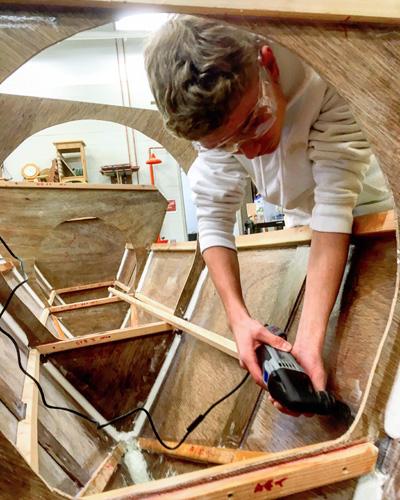The Mini Tiki Takes Shape in a Classroom

On the first day of a new quarter at East Hampton High School last week, the students in Andy Rigby’s woodworking and manufacturing classes wasted no time getting to work on the project at hand, each bending industriously over a portion of what would become the second hull of a 26-foot catamaran they are building under the guidance of David Ryan of the Montauk Catamaran Company.
“The biggest challenge is the short periods, but these guys are figuring it out almost like a factory with shifts now,” Mr. Ryan said on Jan. 31 as he watched an afternoon class carrying out his instructions. In the week since then, he said on Tuesday, “they’ve only gotten better.” Mr. Ryan had worked with separate students over the previous two weeks to build the first hull.
“What has just been exhilarating to me is watching guys stay a couple minutes when they have to finish things and then just seamlessly pass things on to the next class. It’s just so fun to see.”
By the time he is finished working at the school in late February, he hopes both hulls will be closed up and “ready to be glassed and painted.”
Mr. Ryan, who has a daughter at the high school, has already built two similar boats: the Mon Tiki, a 38-footer that launched in 2012, and the 63-foot Mon Tiki Largo, which he completed last summer. His apprentice builders were adults in those cases, but like the students who are putting together what will be the Mini Tiki, they had never built a boat before either.
He pitched the project to the school’s principal, Adam Fine, Mr. Rigby, and Heather Evans, who, as the unified arts coordinator, oversees both the fine arts and technology education programs like woodworking and manufacturing.
“When you get a project like this, you have to take advantage of it,” Mr. Fine said as he visited the classroom last week to check things out.
Mr. Ryan supplied all the raw materials, from the marine-grade plywood to the glue and epoxy, making the collaboration a win-win for the school. The crossbeams, masts, and rudders were already finished, and his workers had cut out the bulkheads that give the hulls their structural integrity.
The hulls and crossbeams will eventually be lashed together with rope, Polynesian-style, but outside the school shop. The boat will have a 15-foot beam when it is finished.
“We were at the point where we were going to see a lot of pretty impressive visual growth in the project,” Mr. Ryan said. That seemed a good point to bring the students into the process.
The students have already learned some of the skills they need to do the project. Mr. Rigby teaches the basics in Woodworking 101. More advanced students move on to building construction, and “then we start introducing machinery to them,” he said. “In a manufacturing class we take an item and try to market it, make a prototype and break down the process to figure out how to make it faster and still keep the quality up.” Adirondack chairs in the hallway near the woodshop are the product of that class.
For this project, “We get the kids in here and tell them what we’re hoping to achieve in a class period,” Mr. Rigby explained, and then they get to work. They are “learning the terms behind boating, the ideas of building,” and that this sort of construction is different from building a table or a cabinet. “Some of the cuts don’t have to be as precise.”
“What I would hope that they would learn is that most things are not that hard; what you need is somebody to show you how easy it is,” Mr. Ryan said. “If you get shown that enough times in enough ways, you learn that the world is figure-outable,” a lesson that applies beyond the classroom as well.
“I want to teach people to be confident in their judgment,” he said. “You might make a mistake. That’s part of learning. It’s not a big deal. Use your confidence judiciously as a tool to solve things that you come up against.”
The first day the students walked in “they looked so lost,” Mr. Ryan said. “Two days later, they don’t look lost at all, they look like builders.”
Working off plans by James Wharram, a noted British designer of multihull boats, they were at first charged with gluing and sanding as the hulls were assembled.
Now they are doing epoxy joinery — “We call it plastic welding,” Mr. Ryan said — and learning to work with a material they have never used before.
He hopes to spend two or three more weeks in Mr. Rigby’s classroom before he heads to Maryland to collect Mon Tiki Largo from its winter storage spot and begin readying his fleet for the busy charter season ahead.
Community engagement is a key part of his company’s mission, and working in the school “seemed like a natural extension of that,” Mr. Ryan said. He takes school groups, scouts, and nonprofit groups out on the boat as part of what he calls the Mon Tiki Floating Classroom Project during the spring and fall. The cost to him is nominal, and the benefits are many. “The boat is happier moving than sitting, and I’m happier moving than sitting.”
He expects to launch the Mini Tiki sometime this summer. It and the other boats in the Montauk Catamaran Company fleet will sail out of the Montauk Yacht Club this summer.
